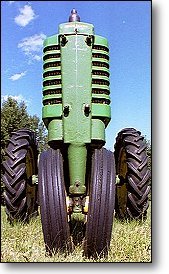Why do the front wheels slant?
I'm Miss Information,
But, please call me Meli...
|
> Meli... > Why are the double front wheels on the > A and B models not perpendicular ?  These are "rowcrop" tractors, designed to be able to handle "cultivating" duties. The idea is to have the wheels as CLOSE together as possible so that they will go between rows of crops as narrow as where the rear wheels will go. There ARE tractors with just ONE front wheel, but that way generally the "footprint" is so small that the weight of the tractor makes the front tire sink into the ground a bit too deep, causing VERY difficult steering.
These are "rowcrop" tractors, designed to be able to handle "cultivating" duties. The idea is to have the wheels as CLOSE together as possible so that they will go between rows of crops as narrow as where the rear wheels will go. There ARE tractors with just ONE front wheel, but that way generally the "footprint" is so small that the weight of the tractor makes the front tire sink into the ground a bit too deep, causing VERY difficult steering.
> It would seem that the weight of the tractor
> I have tried to find the reason in Come to think of it, I haven't seen anything written about it EITHER!! That's what I am here for.
> I might be totally mistaken but on
You are right, but it's because most modern tractors are not "rowcrop" type tractors. They do not have the "narrow front", so there is no reason to slant the wheels.
The "tricycle" or "rowcrop" front end allows the tractor to make a
180 degree turn in a space no greater than twice its width. This is
very handy for going up and down the rows of crops and for making square
corners when mowing. The drawback is that the tractor can be unstable
on hilly ground and can easily tip over if one rear wheel goes into a
ditch. A four-wheel tractor avoids this problem. |
| |
Go back to the page you just came from......
"Wheels"
 So, the wheels are slanted to allow the tractor to be supported by a substantial pedestal and still allow the tires to almost touch each other at the bottom. The axles are, of course, DESIGNED for this set up, and they seldom, if EVER, need to be replaced. Yes, wear would occur to the corners of the tires if ordinary "truck tires" were on there. However, proper tractor tires are designed with three ribs, and they do not HAVE corners.
So, the wheels are slanted to allow the tractor to be supported by a substantial pedestal and still allow the tires to almost touch each other at the bottom. The axles are, of course, DESIGNED for this set up, and they seldom, if EVER, need to be replaced. Yes, wear would occur to the corners of the tires if ordinary "truck tires" were on there. However, proper tractor tires are designed with three ribs, and they do not HAVE corners.